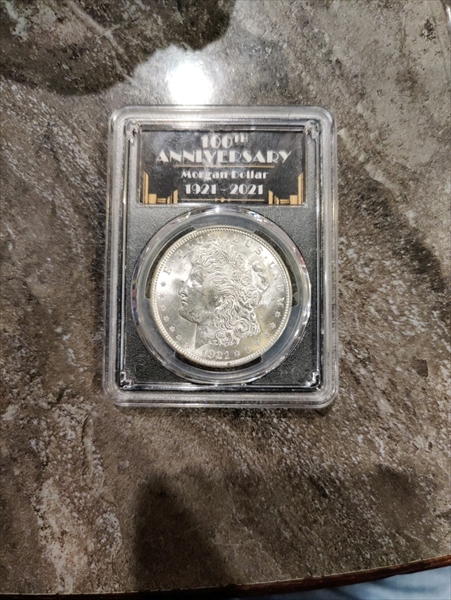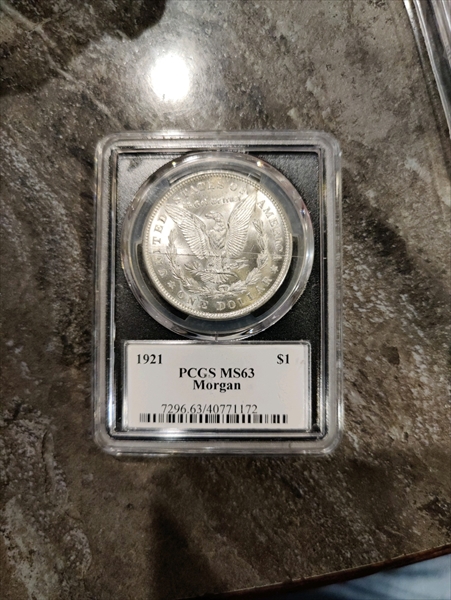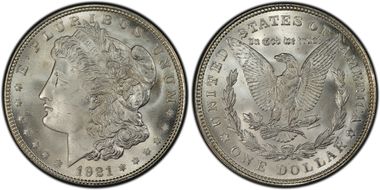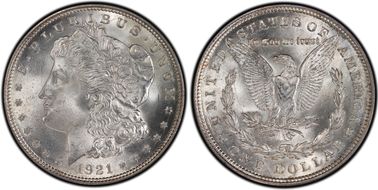1921 $1 Morgan MS63 认证号40771172, PCGS号7296
专家评论
Q. David Bowers
The following narrative, with minor editing, is from my "Silver Dollars & Trade Dollars of the United States: A Complete Encyclopedia" (Wolfeboro, NH: Bowers and Merena Galleries, Inc., 1993).Coinage Context
An unnecessary coinage: The coinage of Morgan silver dollars in 1921 was accomplished under the provision of the Pittman Act of April 23, 1918, which mandated that hundreds of millions of older silver dollars be melted down into bullion, and that the government should take the proceeds and buy new silver for a price of $1 per ounce, a considerable premium over current market levels. This was a sop to Western silver mining interests.
While the Bland-Allison Act of 1878 and the Sherman Silver Purchase Act of 1890 mandated the purchase of unneeded, unwanted silver bullion at current market price, the Pittman Act dictated that the government pay considerably more than market. As usual, American taxpayers bore the brunt of the effect.
There was little interest at the Mint in the recoinage program, and it was deemed expedient to resurrect the old Morgan design for further use. The earlier hubs had been destroyed in 1910, when no-body expected any further coinage of Morgan dollars. Morgan (with help from J.R. Sinnock) made copy hubs based on an 1878 7 Tailfeathers PAF, but in shallower relief and much poorer quality. Apparently, the original hubs had been destroyed or were deemed unfit for use, so new transfer hubs were made, these being of shallower relief and much poorer quality that those used during the earlier era.
Numismatic Information
Commentary: In 1921, the Mint redesigned the Morgan dollar. The new coin was in shallow relief with many features less well defined than on earlier (1878-1904) issues. Comparison of a 1921Morgan dollar (from any of the three mints) with an issue from the early 1900s will show many differences.
On the obverse of the 1921, the portrait of Miss Liberty is very shallow, and the cheek is almost flat; the lines of her hair are bolder and better defined; and there is no crease above her chin, among other distinctions.
On the reverse of the 1921, the eagle is flat with virtually no breast feather detail, the arrow feathers are parallel (copied after an 1878 7 tail feathers, parallel arrow feathers, reverse), and the stars are slightly larger.
In 1910, six years after the last coinage, the Engraving Department at the Philadelphia Mint believed that the days of the Morgan dollar were gone forever, and old hubs were destroyed. When the order came in 1921 to rush production of more Morgan dollars, new hubs were made by George T. Morgan and John R. Sinnock, but in shallow relief in order to facilitate quantity striking in a hurry. It was realized that one thing the world needed was not more silver dollars, and that most would simply go into storage (where countless millions of earlier dates already were in moldering bags). There was no need to consider aesthetic appeal.
The dollars of this year have an interesting distinction: a monograph, The 1921 Morgan Dollars: An In-Depth Study, by Mike Carter, was written about them. The author devoted over two dozen pages to the various aspects of dollars from the three mints. In his introduction, the author noted in part:
I love 1921 Morgan dollars! I am one of the very few numismatists who would ever say such a ridiculous thing .... They have been shunned by collectors and investors alike for various reasons from being poorly struck to being the most common of all the Morgan dollar dates. I believe that the 1921s have been treated unjustly, and in the ensuing text we will take a look at some interesting facts about these dollars that just may change the minds of more than a few of you.
Hoard coins: Many bags of coins were released over a long period of time. Eventually, they became so common that dealers' buying prices for Uncirculated bags and rolls of Morgan dollars often said "except 1921." As a result, most bags were broken up. Today, relatively few original mint-sealed bags exist. However, individual coins from these bags are exceedingly common.
Circulated grades: Worn 1921 dollars are extremely common. Probably, 10 to 15 million exist. Time was in the mid-1960s when the majority of dollars seen at Nevada gaming tables were 1921 dollars (Philadelphia coins primarily, but also Denver and San Francisco Morgan dollars). Many millions were melted in the run-up of silver bullion prices during the 1970s.
Mint State grades: Nearly all pieces are very poorly struck. This, added to the shallow relief of the dies, is responsible for the unsatisfactory appearance of nearly all specimens in existence today. Even coins certified as MS-65 are apt to be ugly in this regard. I have seen "MS-65" coins that would be graded no better than MS-61 or MS-62 if they were of earlier dates. If you want to see an amazing study in contrasts, simply compare a certified MS-65 1881-S dollar with a like certified 1921 Morgan; there is virtually no similarity whatsoever!
Most known specimens are in low grades such as MS-60, 61, or 62. The striking is so poor that the difference between an MS-60 and a lightly circulated AU-58 is often moot.
I offer these population estimates: MS-60 to 62, 5,000,000 to 8,000,000; MS-63, 1,000,000 to 2,000,000; MS-64, 200,000 to 400,000; and MS-65 or better (per current standards), 20,000 to 40,000.
Lustre varies from dull to frosty. Those that are frosty are apt to have dull areas on the higher points, particularly the face of Miss Liberty.
Prooflike coins: Prooflike coins are scarce in relation to the overall mintage of 1921, but on an ab-solute basis are easy to find. Probably, tens of thou-sands exist. The data from the certification services inform us that numerous DMPL coins also exist, but many of these are not what I would call DMPL. It is popular to offer certain of these as "Zerbe Proofs." Wayne Miller suggested that a hairlined (from in-complete polishing) Proof die was used to make circulation strike dollars. Be careful when buying a PL or DMPL of this date. Thomas K. DeLorey is one of several experts who agree with me that these "Zerbe Proofs" are, in fact, prooflike circulation strikes.'
Die rotation: VAM-3 is known with the reverse die misaligned 45° from the normal orientation. Examples exist in Mint State.
Proofs: In my opinion, true Proofs with deep mirror surfaces are exceedingly rare. The situation is obfuscated, however, by a profusion of prooflike coins from hairlined dies sold as "Zerbe Proofs," or with other nomenclature. Walter H. Breen and I differ in our opinions in this area; he considers more coins to be Proofs than do I. As related under 1921-S below, "Zerbe Proofs" are supposed to have S mintmarks! However, Breen recalls a conversation he had with Wayte Raymond in 1951, who told him that Zerbe had Proof 1921 Morgan dollars (of this hairlined finish style) made at the Philadelphia Mint to accompany the 1921-S "Proofs" he already owned.
Mike Carter in his monograph, The 1921 Morgan Dollars: an in-depth study, commented as follows: "We must keep in mind that these coins are not Proofs in the real sense of the term, but presentation strikes." This statement tells it all, and should be underlined by users of this book, who contemplate paying very high prices for such pieces. In fact, I have underlined it for you.
In 1921, Henry Chapman went to the Mint and had some mirror-surface Proofs struck to his order. This was done clandestinely by or for George T. Morgan, chief engraver, who had a little "rare coin business" going on the side. Walter H. Breen reported that he has seen "the bill of sale for 10 Proofs, Morgan to Chapman." The original production of mirror-type Proofs must have been very small, perhaps just 15 in all (10 to Chapman, five to Ambrose Swasey). They were not officially sold by the Mint, nor were any Proof sets made that year.
In Thomas L. Elder's sale of the C.W. Stetson and other collections, December 4-6, 1924, Lot 1954 consisted of a 1921 Morgan dollar described as follows: "Brilliant Proof. First I have met with in this condition." The buyer was Henry Chapman, who paid $5.75. It seems unusual that Chapman would have paid $5.75 for a Proof, which was a very strong price for any Proof Morgan dollar. Of course, there is the strong possibility that Chapman was still holding a stock of them and sought to pay $5.75 at auction to increase the value of those he already had. It is worth noting that Thomas L. Elder, certainly one of the most informed dealers of the era, apparently had not seen a 1921 Proof earlier.
In connection with the preparation of this book, Walter H. Breen said the following concerning 1921 mirror-surface Proofs:
On the five Proofs Engraver Morgan sold to Ambrose Swasey, 6/4/21, and the 10 Morgan sold to Henry Chapman a week later, a short line points from rim to third star, and ends about 1 mm away; two die polish lines up from rim to first 1; hollow around Morgan's initial M (from overpolished die). Reverse dash between right star and wreath, touching neither; another, fainter, slanting up from left upright of I(CA); a third between S(T) and I of In, touching neither; faint scattered die striations around UN AM RICA.
True mirror Proofs are exceedingly rare. Scott's Comprehensive Catalogue, published in 1971, estimated that seven to nine are known and priced them at $5,500. An example (with some handling marks) in the Rothert Collection Sale, November 1973, Lot 405, fetched $1,900. Wayne Miller's realized $2,420; Norweb's $4,840.
In 1992, Michael Saum showed me a highly polished "Chapman Proof' dollar, a coin which I considered to be an authentic mirror surface Proof. When the coin was held at an angle to a single light source, the obverse and reverse are both flatter (not slightly concave) than typical brilliant Proofs of the 1878-1904 era, with distortions in the mirror fields from the pressure used to put the design on the die, almost like a meniscus on a surface of water. No die striations or polish lines were seen, unlike so-called "Zerbe Proofs." On the reverse, extending diagonally upward to the left from the left side of the I in AMERICA is a minute raised die line. The coin conformed to the Breen mirror Proof criteria given above.
In my career I have handled only two or three mirror Proofs. The historical record of such Proofs, as evidenced from appearances in auction catalogues and price lists, is valueless, as the majority of pieces were, in my opinion, prooflikes, not mirror Proofs.
The matter of "Zerbe Proofs" may never be settled to everyone's satisfaction. Opinions differ widely.
"Infrequent reeding": Some 1921 dollars with 17 berries in the reverse wreath were made from collar dies with 157 grooves instead of the usual 189; these are called "infrequent reeding" or "wide reeding" varieties."
Caveat emptor: Beware of paying high prices for "Zerbe Proofs," even if accompanied by letters or certificates. In my opinion, many if not most, are prooflike, not Proof.
Varieties
REDESIGNED DIES: SHALLOW RELIEF
Circulation strikes:
1. 17 Berries in wreath: Van Allen and Mallis Reverse D-l. Breen-5704, VAM-l, 3, 12, 13 (the last three with certain reverse features tripled). Extra berry appears like a period to the left of center near the top of the wreath (at the base of the topmost leaf cluster) on the right side of the coin. Top arrow feather joins olive branch at the middle talon of the eagle's right (on observer's left) claw. Many minor positional varieties. So-called "Zerbe Proofs" are of the VAM-l variety.
2. 17 Berries in wreath, infrequent reeding: Van Allen and Mallis Reverse D-l. VAM-2, 4 (with N of IN low, and doubled at top). Style as above, but with 157 reeds instead of the normal 189. Reverse often rotated very slightly from the normal alignment. Mike Carter estimated that between 400,000 and 1,000,000 of these were minted.
Note: This infrequent reeding variety does not exist with 16 berries in wreath; earlier listings in VAM and elsewhere were in error.
3-4. 16 Berries in wreath: Van Allen and Mallis Reverse D-2. Top arrow feather joins olive branch between the right and middle talon of the eagle's right (on observer's left) claw. Breen-5705, VAM-3; Raised round dot(s) in field, Breen-5706. Common per VAM, not so common per Jeff Oxman. A fascinating discussion of these dots, thought by Van Allen and Mallis to have been made by a hardness testing tool, is in VAM, p. 125. Dots, which occur in various sizes, also exist on D and S dollars of this date. Jeff Oxman suggested that these dots are not from a hardness tool at all, but resulted from poor die steel;'
The dots were probably NOT made by a hardness testing tool, as VAM suggest. In the first place, there are literally too many dots on too many varieties, some varieties showing more than one dot. What would the point be? Look at the photo of VAM-87, and it hardly looks like the product of a hardness tester. I believe it more likely that poor quality die metal was the culprit. ... The metal was apparently infused with gas bubbles. Wherever the metal was sliced across a bubble, the result would be a spherical indentation on the die face. When coins were struck from such a die, the coins would have what appeared to be a raised dot corresponding to the indentation in the die surface. What is compelling about this line of argument is that the dots are so randomly placed on the dies.
Dies prepared: Obverse: Unknown; Reverse: Unknown. Possibly over 200 pairs.
Circulation strike mintage: 44,690,000. February, 56,000; later months unknown.
Estimated quantity melted: Probably millions under the 1942 Silver Act; many millions more during the late 1970s when silver bullion became very expensive on world markets.
Availability of prooflike coins: Tens of thousands of PL pieces exist; sometimes certain prooflikes are sold as "Zerbe Proofs."
Characteristics of striking: Most are poorly struck and show granularity on Miss Liberty's cheek. All are from shallow dies.
Known hoards of Mint State coins: More or less continuously distributed by the Treasury during the 1950s and early 1960s.
Commentary
The 1921 is the commonest of all Morgan dollars.
Additional Information
Resumption of Dollar Coinage
The April 1921 issue of The Numis
matist told of the resumption of silver dollar production:
"Silver Dollars Again Being Coined: After a lapse of 17 years the coinage of standard silver dollars was resumed at the Philadelphia Mint in February, the report of the month's coinage printed in this issue showing that 56,000 pieces of that denomination were struck during the month. In response to a letter addressed to the Superintendent of the Mint, asking for particulars, the following was received:
"'Replying to your letter of the 11th instant, you are advised that the standard silver dollars now being coined at the Mint are of the same design as those coined in 1904. These coins are not being paid out.'
"As the new coins are not obtainable by the public at the Mint, the inference is that they are being coined to replace those sold to foreign governments during the late war, and on account of which many silver certificates were retired from circulation."
Rapid Coinage of Dollars
The Numismatist, October 1921, printed this article:
"Government Saving Money by Coining Silver Dollars Only: The Philadelphia Mint is cutting down the interest-bearing debt of the United States $5 million a month. All of that comes about because of the concentration of the work of the three United States mints on the coinage of silver dollars to replace 350 million dollars that were melted down during the war to sell to the English as bullion.
"When all those dollars were melted the United States had to call in all the silver certificates-the $1, $2 and $5 'bills,' to speak in common lingo-representing the dollars that were deposited in the vaults of the mints. Under the law of the land the Treasury must hold a silver dollar for each dollar silver certificate issued. So with the melting of the silver dollars the silver certificates had to be recalled. To cover that loss in currency, the government issued short-term certificates of indebtedness bearing 2% interest. The silver dollars now being coined allow for the issuance of new silver certificates which are being used in calling in those certificates of indebtedness.
"There are three mints-Philadelphia, Denver and San Francisco. The Philadelphia Mint is equal in output to those in Denver and San Francisco combined.
"Last April all three plants were started on the making of the silver dollars. They were put on 24-hour working days for six days of the week. Two shifts of 12 hours each are now working in the Philadelphia Mint. Until a few weeks ago there were three shifts of eight hours each. But when Freas Styer succeeded Adam Joyce as superintendent of the Mint the third shift was put to work counting the money in the vaults in the making of an audit due to the change in administration.
"In the four months since April 20 million silver dollars have been coined. There remains on hand to be pressed into coin of the land 30 million ounces of silver, which will make approximately 35 million silver dollars.
"Robert Clark, superintendent of coinage in the Philadelphia Mint, says that the greatest production in the history of the plant is now being obtained. The daily average in production for the last month has been 260,000 silver dollars. In some days it has run as high as 275,000. That rate will be maintained until the present supply of silver is exhausted, and then the Mint for a time will go back to the coining of the smallest coins. It will take probably two years, according to Mr. Clark, to coin all of the 350 million silver dollars that will be needed to replace those melted down for England.-Philadelphia Public Ledger."
The above explains the small mintages of subsidiary silver and minor coins dated 1921, and the absence of any dated 1922.The Denver Mint ran out of dies for 1922-D cents, but could obtain no more, using the lost dies until they were so worn that the D mintmark could not be seen; the rest of the year had to be devoted exclusively to silver dollars.
The new silver certificates mentioned above are the Series of 1923.
Ron Guth
According to a notice in the June 1934 issue of The Numismatist (p. 416), collectors could still purchase Uncirculated 1921 Morgan Dollars for "the face value of the coins and an amount sufficient to cover the mail charrges by first-class mail."
PCGS #
7296
设计师
George T. Morgan
边缘
Reeded
直径
38.10 毫米
重量
26.73 克
铸币数量
44690000
金属成分
90% Silver, 10% Copper
更高评级数量
58461
评级较低的钱币数量
19623
地区
The United States of America
价格指南
PCGS 数量报告
拍卖 - PCGS 评级的
拍卖 - NGC 评级的
稀有性和存量估计 了解更多
| 所有评级 | 4470000 |
| 60或以上 | 360000 |
| 65或以上 | 13500 |
| 所有评级 | R-1.0 |
| 60或以上 | R-1.7 |
| 65或以上 | R-2.9 |
| 所有评级 | 94 / 117 TIE |
| 60或以上 | 99 / 117 TIE |
| 65或以上 | 87 / 117 TIE |
| 所有评级 | 94 / 117 TIE |
| 60或以上 | 99 / 117 TIE |
| 65或以上 | 87 / 117 TIE |
























